Pharm Exec’s 19th Annual Industry Audit
Our latest review of biopharma financial performance reveals solid growth rates in enterprise value and rebounding value-to-sales numbers—proving once again the business imperative of regaining and sustaining shareholder value.

Welcome to Pharm Exec’s 19th Annual Pharmaceutical Industry Audit. We present a unique financial performance analysis of the top 18 publicly traded biopharmaceutical companies based on sales revenue. That total is down to 18 this year due to the acquisitions of Celgene, by Bristol Myers Squibb, and Allergan, by AbbVie. The Audit is focused on a number of financial performance metrics, particuarly critical metrics such as growth in shareholder enterprise value, enterprise value to sales, and return on invested capital. Regarding the latter metric, the 2020 Audit examines the impact of weighted average cost of capital (WACC) factored into last year’s numbers. WACC adjusts return on invested capital (ROIC) by assessing the difference between ROIC and WACC.
Methodology
This year’s Audit relies on secondary reported information for the 2018–2019 time period. The metrics are also weighted reflecting their relative importance in assessing a company’s performance. Some metrics are more important than others. For example, sales growth is important, but sales growth can occur as a result of mergers and acquisitions and in-licensing. So, it takes a back seat to the crunch metric, ROIC, which measures how well a company is managed, including margin management (the profit and loss or income statement) and asset management (use of assets on the balance sheet), and, most importantly, whether ROIC exceeds the cost of capital (cost of debt and the opportunity cost of stock equity).
Two metrics are included that are not weighted: sales, general and administrative (SGA), or overhead; and profit per employee.
The higher a company performs on a metric is reflected in a ranking based on the number of points it receives per metric. The highest placing for each metric is 18 based on the number of firms in our Audit, and the lowest is one. For example, if a company places 17th (second highest) on the critical metric enterprise value to sales (EV/S), it receives 51 points on the metric (18 rank x weight of 3). In another example, if a company comes in at a ranking of five (five places from the bottom) on the metric gross margin (pricing power), its total points would be 10 (5 rank xweight of 2).
Indices
Basic indices are the growth of the US economy and inflation. An organization has to be able to grow faster than the US economy: around 3% in 2019, and higher than inflation as measured by the Consumer Price Index (CPI): about 2% for 2019.
Other important benchmark metrics are posted in Figure 1 below.
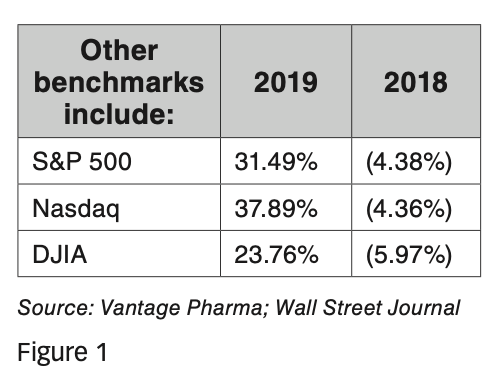
Sales growth
Table 1 below shows sales in US dollars along with sales growth for 2018-2019. It is good to grow, especially organically, compared to just acquiring companies. But that’s easier said than done for organizations at absolutely high sales levels, such as Johnson & Johnson, Novartis, and Roche.
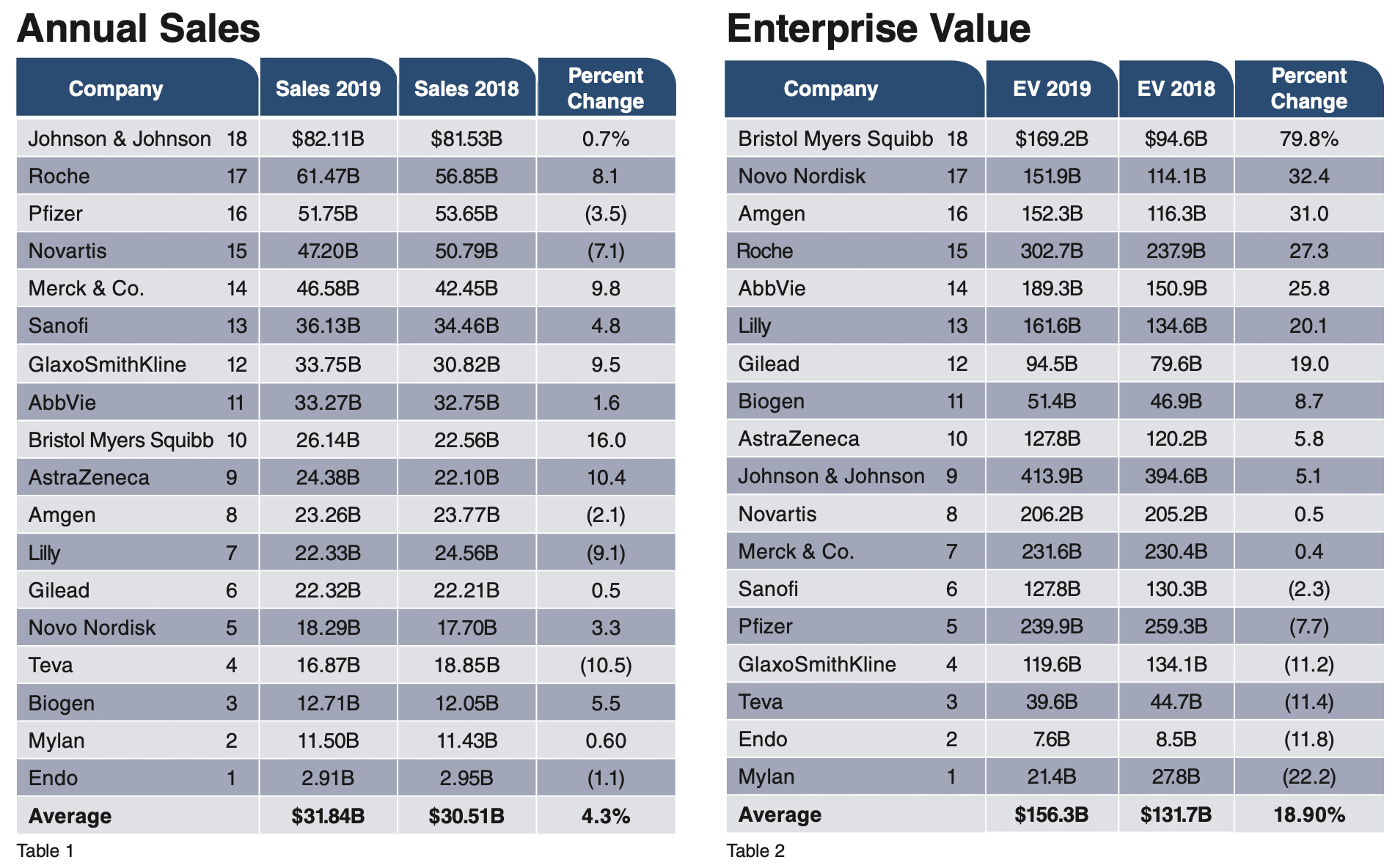
The poster firm for growth is Amazon. Amazon’s profits pale in comparison to its retailer competitors such as Walmart, but its enterprise value (EV), or market cap, is the envy of its peers, less stellar sales growth, notwithstanding.
The average dollar sales for our 18 pharmas was $31.84 billion in 2019, vs. $30.51 billion the previous year, a growth rate increase of 4.3%, outpacing the US economy and inflation. The top pharma by total revenues last year was J&J at $82.11 billion. BMS posted the highest growth rate at 16%, due in part to the its Celgene acquisition. Six companies’ sales decreased last year.
Enterprise or shareholder value and growth
This is the first of three crunch metrics. EV/Sales and ROIC are the others. There are other worthy performance metrics (e.g., corporate responsibility, sustainability, the best places for women and minorities to work, etc.), but our focus is financial performance and enterprise value and growth. Did a company create or add to shareholder (enterprise) value or destroy shareholder value?
EV is the sum of an organization’s market capitalization; then add in debt and adjust for cash and other current assets. Simply put, EV is the market value or market capitalization of a company.
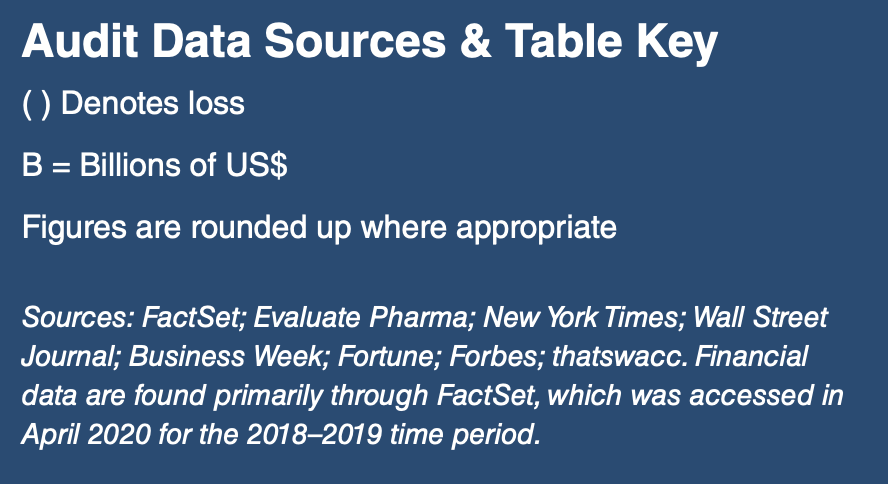
At present, two firms are duking it out for the highest company value on earth: Microsoft and Amazon, with each approaching market caps of $1 trillion.
Table 2 above shows that the pharma with the highest EV is J&J at $414 billion, with an average growth of shareholder value for the year of 5.1%. The company that grew its EV the most was BMS, with a 79.8% spike, in no small part due to Celgene’s strong EV position. To put that in perspective, the average EV for our 18 pharmas in 2019 was $156.3 billion, a growth rate of 18.9%. Of the 18, 12 firms increased shareholder value, and six experienced a drop in their EV. Novo Nordisk ranks second, with a growth rate increase of 32%.
Now compare shareholder value and market cap growth to the benchmarks in Figure 1. Compare the overall 18.9% growth rate to those benchmarks. Biotechs outperformed their mainstay pharma peers on shareholder value.
Enterprise value to sales
EV and EV growth are very important performance metrics. EV to sales supplements that metric by assessing which firms are still climbing, vis-à-vis companies whose best performance is behind them, via so called “value” stocks—those stocks for widow or orphan drugs that, if not growing in value, still pay noteworthy dividends and are solid businesses.
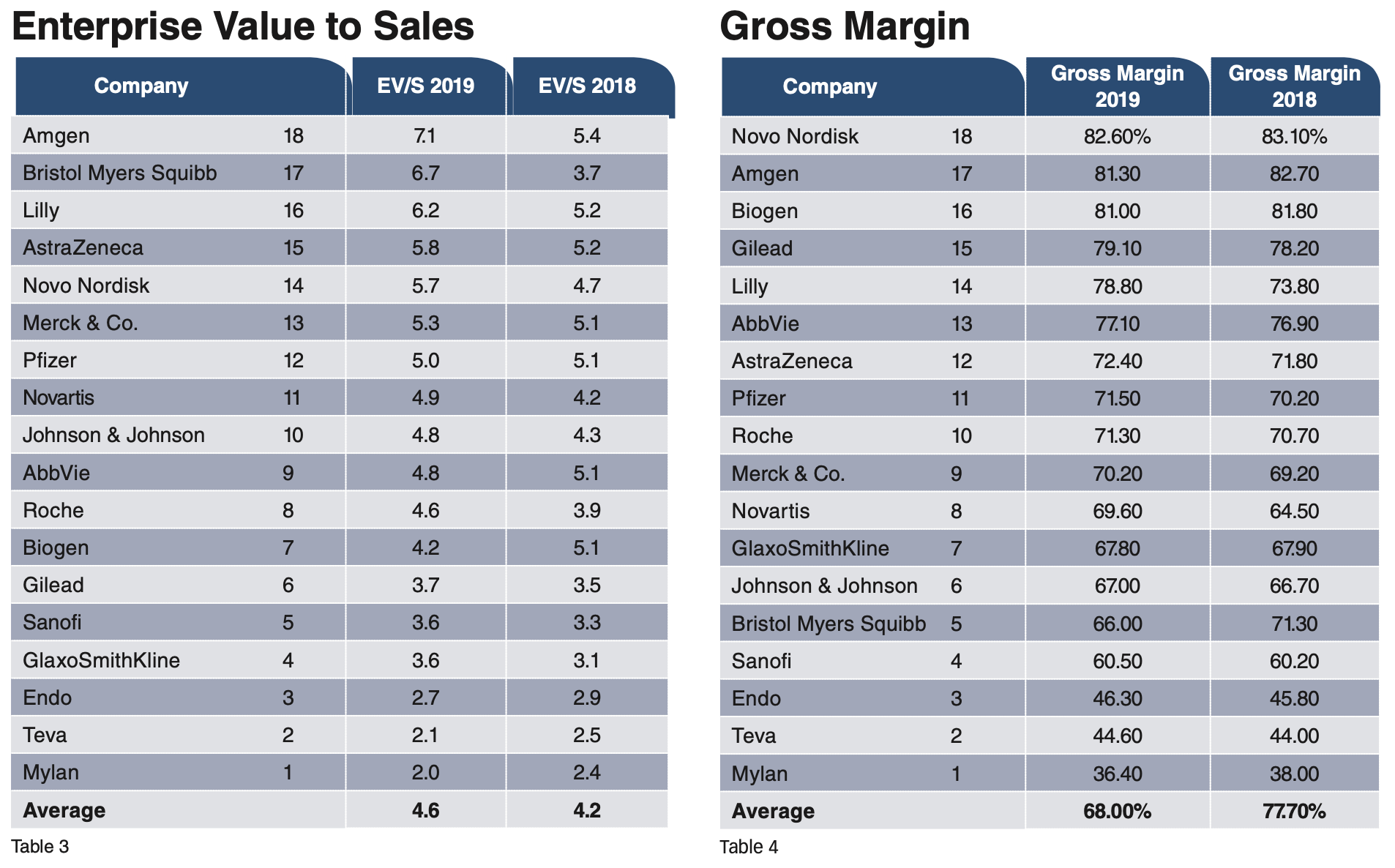
Table 3 lists EV to sales. The average EV/S for 2019 is 4.59, an increase from 2018’s 4.20. At the top of the list is Amgen at 7.1, an increase from the drugmaker’s 5.4 EV/S in 2018. Twelve companies increased their EV/S ratios: the higher the ratio, the more likelihood the company’s performance is going to get better.
Gross margin
Yes, there is net-net and list price vs. net price, but at the end of the day, there is gross margin, which is tantamount to markup. As Warren Buffet would call it, “the moat around your castle.”
Gross margin reflects a company’s power to maintain or, even better, increase price. The metric represents total revenue minus cost of goods sold from the income statement. This is quintessential margin management: how price is managed while simultaneously managing operating costs to produce net income. The higher the gross margin is, the more a firm is able to cover operating expenses, including SGA. Table 4 above shows Novo Nordisk at the top with a gross margin of 82.60%, a slight decrease from 2018. The biotechs rule pricing as they have ever since the first Pharm Exec Industry Audit in September 2002. But note the significant drop in gross margin average for our 18 pharmas, from 77.7% in 2018 to 68% in 2019. Ten firms were able to increase their gross margin, with Lilly and Novartis raising it the most.
Operating income
Staying with margin management, Table 5 below shows pre-tax operating income, or profit to sales. Again, the higher the gross margin is, the more that contributes to improving pre-tax, operating income. Operating income consists of total revenues minus cost of goods sold and minus operating expenses related to a firm’s typical business. It excludes one-time gains and losses, dividend income, and interest income.
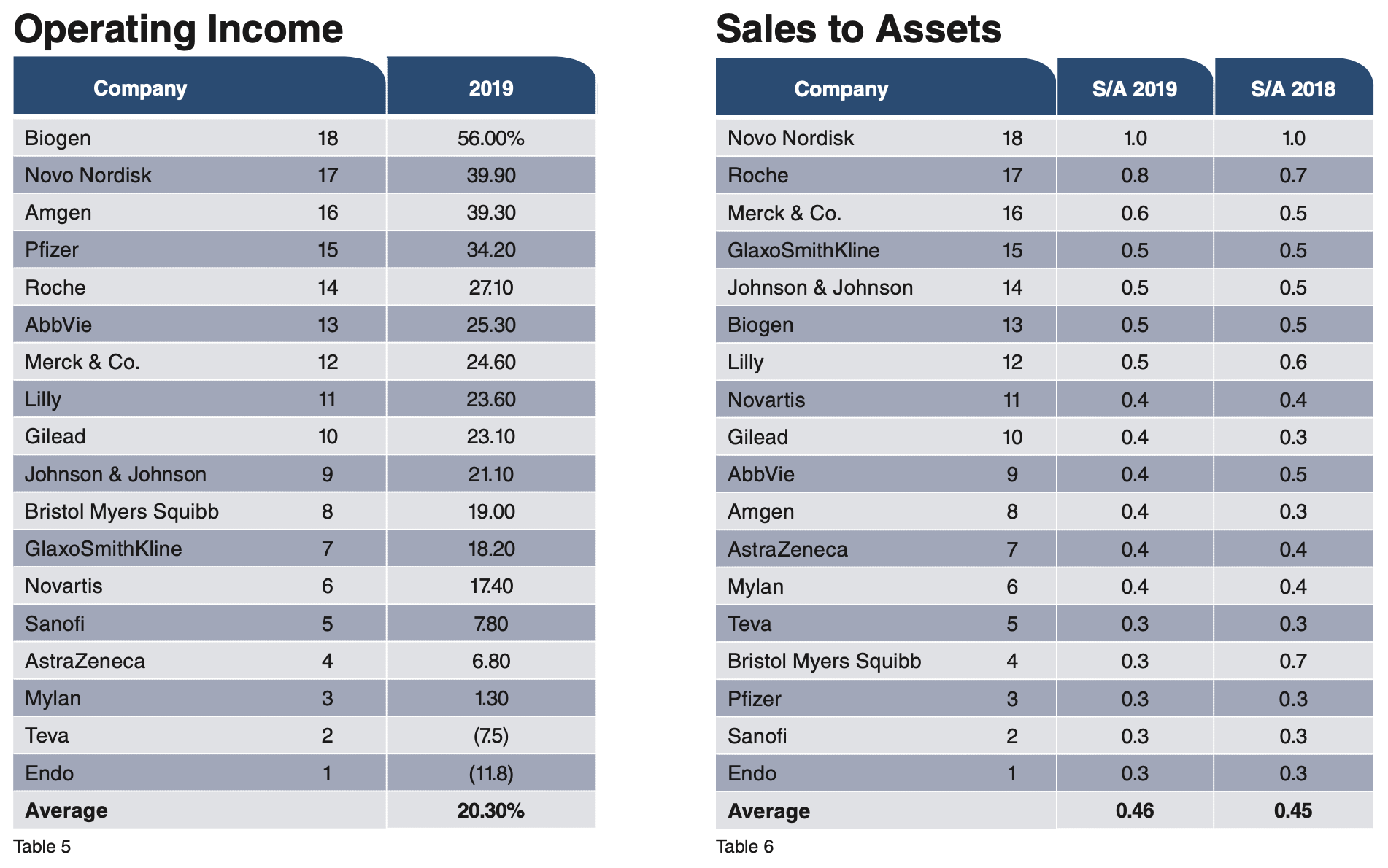
At the top in this metric is Biogen at 56%, a seven-digit increase from 2018. To put that number in perspective, 56% would qualify as a decent gross margin; for Biogen, it is its pre-tax operating income. The average figure for 2019 was 20.3%, a significant six-digit drop from 26.3% in 2018. Only eight of our 18 companies saw their pre-tax operating incomes increase for the year.
Sales to assets
Gross margin and operating income have to do with margin management; sales to assets has to with asset management. If a firm is at $70 billion in sales, it won’t be doubling revenue anytime soon. If the company has also curtailed SGA and disposed of assets, it won’t be cutting operating expenses in half anytime soon either. Then it turns to asset management to do a better job making use of, not necessarily owning, assets.
When you multiply profit to sales (pre-tax operating income) by sales to assets (asset management), you get a far more important measure: return on assets. An organization can have a relatively low profit margin with a relatively high sales-to-assets ratio that will result in a better performance in terms of ROIC.
As seen in Table 6 above, Novo Nordisk’s sales-to-assets ratio is 1.0. For every dollar invested in assets, Novo Nordisk gets back $1. Roche comes in at No. 2, getting back 80 cents for every dollar invested in assets. Only six companies rank above average regarding how productive they are in managing their assets.
Returned on invested capital
Now we come to the mother of all Audit metrics: ROIC. ROIC is net income left over to shareholders as a percent of debt and common stock. According to longtime organizational consultant Mark Van Cleaf in The New York Times, the best measure of business performance is ROIC—how much is a company generating on its capital investments, plant and equipment, minus the cost of that capital, debt, and equity?
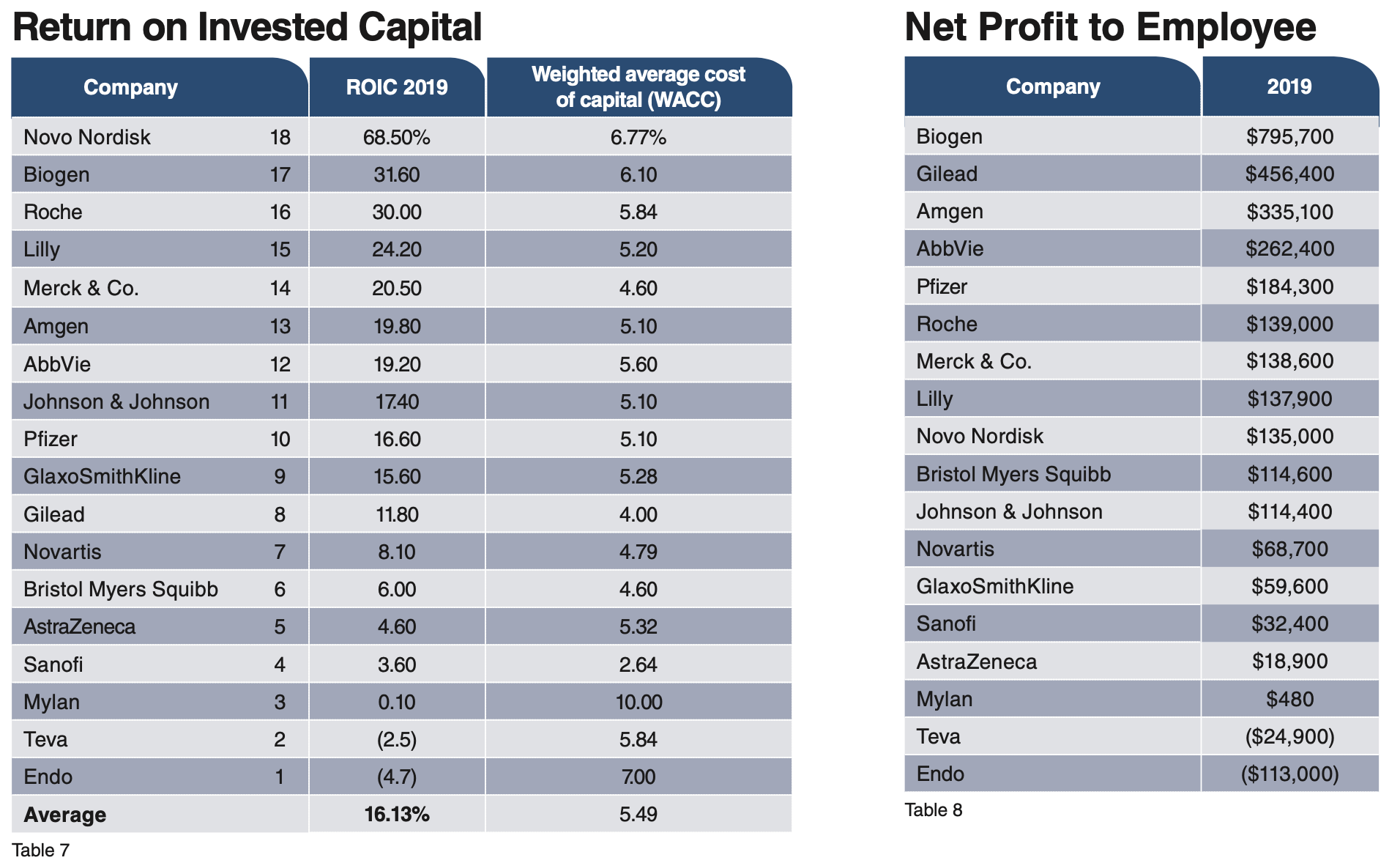
Combine this with our relatively new addition to the Audit, weighted average cost of capital (WACC). Management should be providing value that exceeds its cost of capital, according to Van Cleaf. For example, two organizations can have an ROIC of 10%, but company 1 has a WACC of 12% while company 2 has a WACC of 7%. The first firm is destroying shareholder value while the second one is creating shareholder value.
Prior to the mid-1980s, the conventional wisdom was that debt had a cost (the rate you pay for borrowing) but issuing stock was free. But what if the peer groups an organization competes with have a higher ROIC than the company? Even though the firm shows a profit, it is destroying shareholder value if its profit is below its peers’ average.
What return could an investor get by investing in an organization of equal risk? This was the brainstorm of Stern Stewart, a consulting firm based in New York City.
Our source for WACC relies on three years of income statements and balance sheets to arrive at a firm’s WACC percentage.
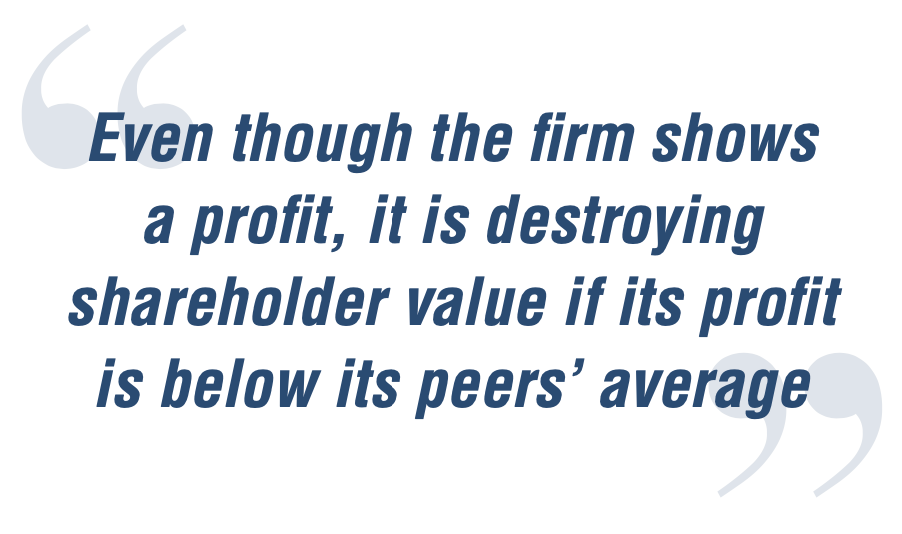
Table 7 above shows Novo Nordisk far out in front, with a ROIC of 80%. Biogen ranks second at 31.6%. Average ROIC increased to 16.13%, from 14.54% in 2018.
Half of our 18 companies increased ROIC while the other half saw that number drop.
To avoid overstating the impact of ROIC, and double-counting its value, we use the ROIC number to come up with the rankings on this metric. But the inclusion of WACC in Table 7 tells an interesting story: The greater the difference between ROIC and WACC, the greater the return to shareholders.
The top 10 organizations substantially created shareholder value, with double-digit increases in the spread between ROIC and WACC.
Net profit per employee
This metric, presented in Table 8 above, is not weighted in the rankings. It is interesting, however, to show how profitable the pharma sector is. Biogen produces the most profit per employee of our 18 pharmas, at $795,700 each, up from $563,038 in 2018.
Selling, general and administrative expenses to sales
SGA is another metric that does not impact the rankings. Nonetheless, it is still important because the expenses in this category are necessary to run an organization and constitute routine spend such as rent, salaries, advertising, marketing, legal, and more. Laying off and firing workers costs money in severance before it begins to pay off. It’s also important to keep in mind that this is a one-year comparison.
A company can be making investments in advertising, training its sales force, etc., and that will pay dividends down the road. One swallow does not a season make.
Opportunities exist to cut advertising costs by being more efficient with agencies and revamping supply chains. Also, SGA can increase, but it is the goal for sales growth to grow faster, thereby lowering the SGA-to-sales ratio. Ballooning overhead leaves a firm inefficient and less productive than it otherwise could be.
Table 9 below shows that generics makers are lean and mean on this metric, before Biogen enters, producing the fourth-lowest percentage number. The average SGA for 2019 was 41.6% of sales, vs. 42.4% in 2018.
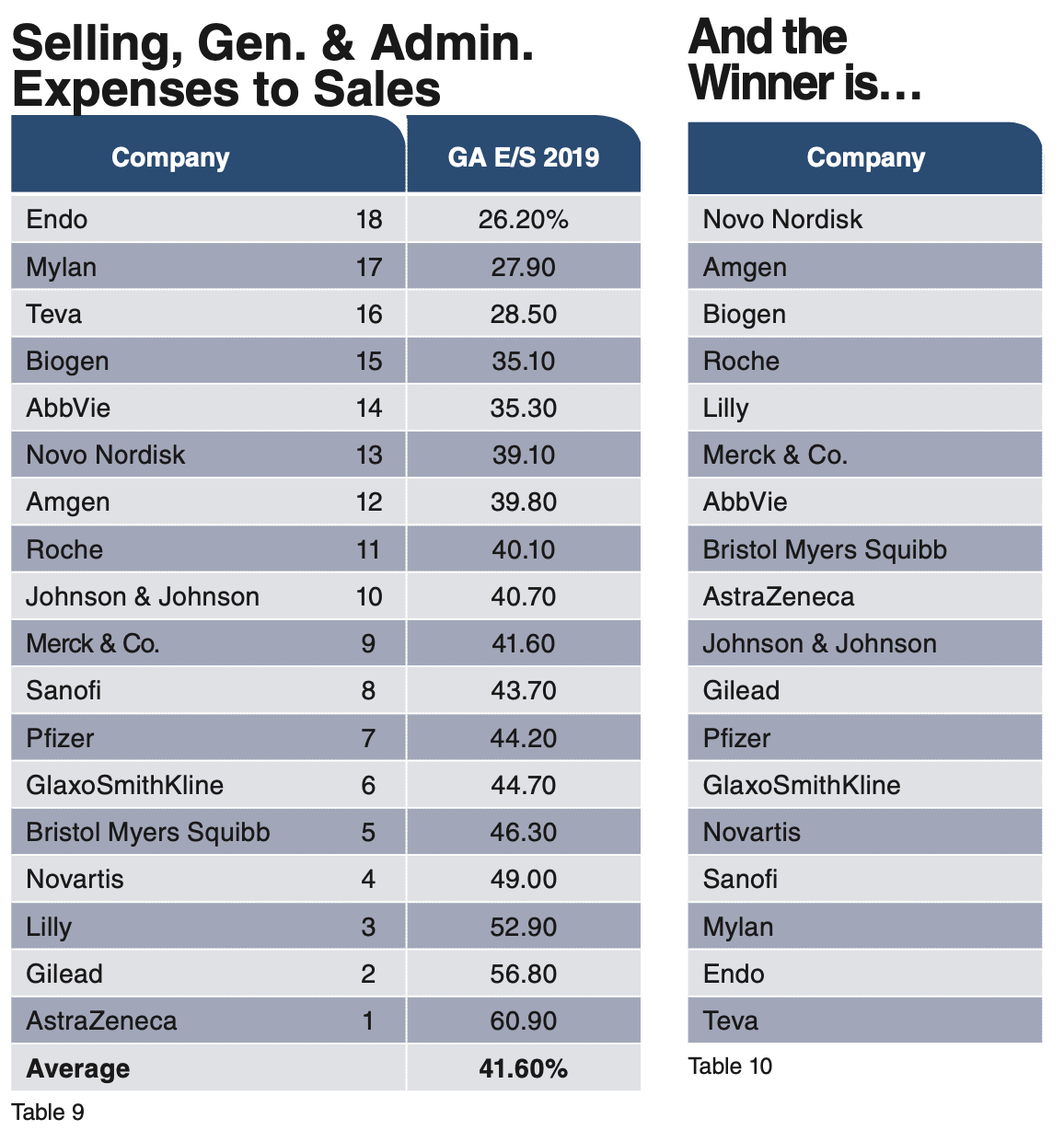
Audit standouts
Table 10 above reveals the winner of this year’s Audit: Novo Nordisk. Repeating for the second consecutive year, the Danish-based drugmaker totaled 275 points, according to our scoring system explained in the methodology section.
Novo Nordisk finished among the top two spots in five of the metrics weighed.
Amgen comes in second overall with 239 points, followed by Biogen (229) , Roche (227), and Lilly (216) rounding out the top five.
About the author
Bill Trombetta, PhD, is Professor of Healthcare Strategy & Marketing at St.Joseph’s University Haub School of Business in Philadelphia. He can be reached at trombett@sju.edu.
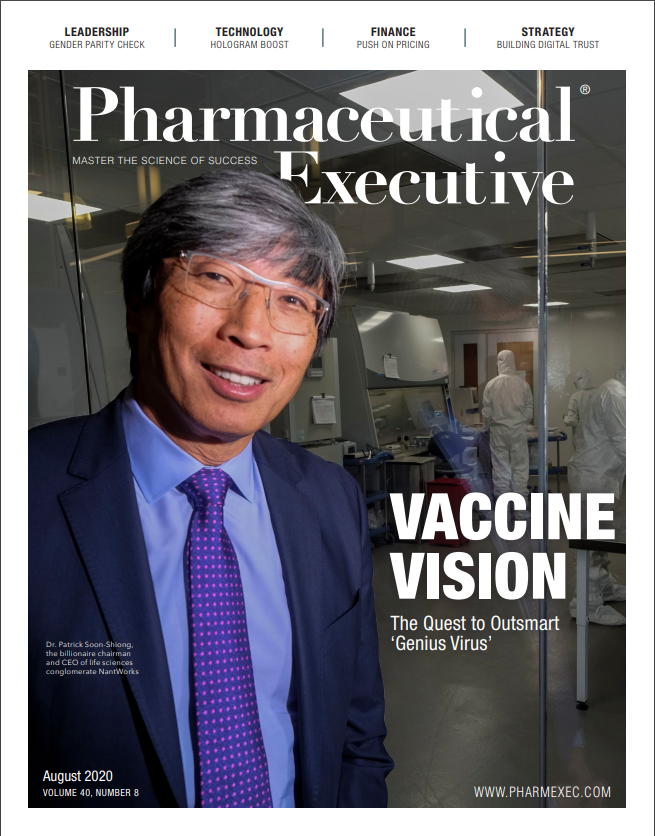
Regeneron, Roche Launch Major US Expansion Plans to Meet Growing Demand for Biologics and Innovation
April 22nd 2025With combined investments exceeding $53 billion, both companies are deepening their US presence through expanded biologics production, gene therapy capabilities, and next generation R&D centers.
The Misinformation Maze: Navigating Public Health in the Digital Age
March 11th 2025Jennifer Butler, chief commercial officer of Pleio, discusses misinformation's threat to public health, where patients are turning for trustworthy health information, the industry's pivot to peer-to-patient strategies to educate patients, and more.
Navigating Distrust: Pharma in the Age of Social Media
February 18th 2025Ian Baer, Founder and CEO of Sooth, discusses how the growing distrust in social media will impact industry marketing strategies and the relationships between pharmaceutical companies and the patients they aim to serve. He also explains dark social, how to combat misinformation, closing the trust gap, and more.